One of Gretna’s favorite treasures is the 1876 steam fire pumper that was once pulled by the men of the David Crockett Fire Company No. 1, the oldest, continuously active volunteer fire company in the United States.
The old pumper is housed at 205 Lafayette Street in the Louisiana Fire Museum. The 161 year-old building stands as a monument to the history of firefighting. It was designated the official Louisiana Fire Museum during a Louisiana legislative session in 1986.
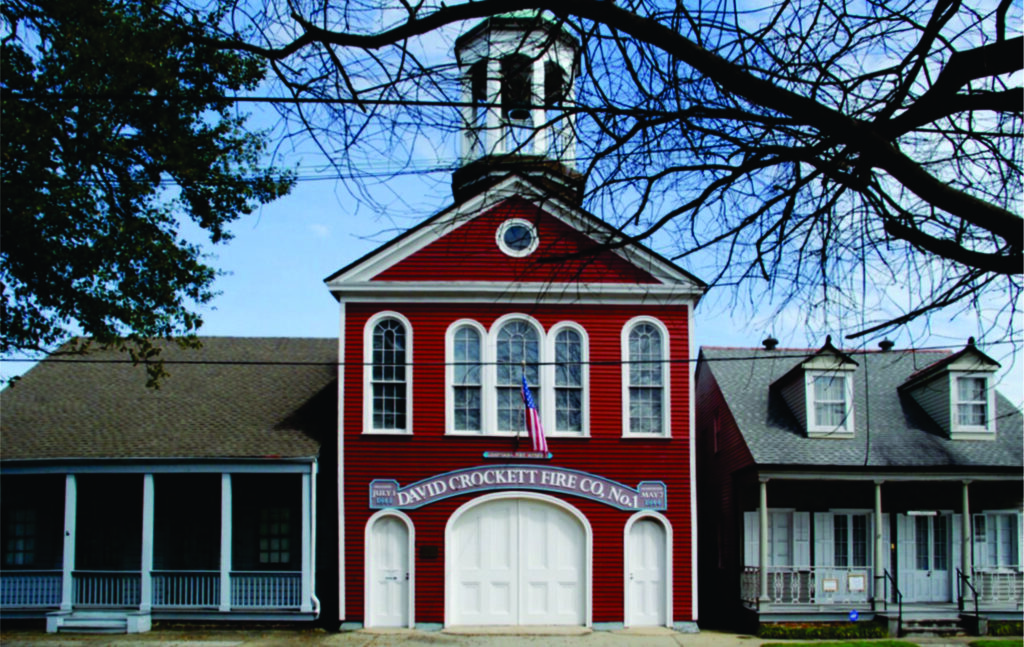
A historical treasure itself, the firehouse was built in 1859 on land purchased that year for $350. The star of the fire house is its “pride and joy,” the old steam pumper parked in the center for all to appreciate.
The fire museum building is a part of the Gretna Historical Society Museum Complex. Besides the fire museum, there are also four other structures to visit. A tour of the complex is open and free to the public with social distancing and masks required.
Gretna’s hand-drawn steam pumper is a fifth class copper, brass and steel fire engine manufactured in 1876 in Burlington, Vermont and bought that year by the fire company for just $1 per pound. The hand drawn Gould #31 pumper is the only one remaining that was manufactured on a Gould patent. It is also probably the only one under its original ownership and remaining in its original firehouse setting.
The pumper weighs approximately 3,000 pounds and rests on four wooden wagon wheels that have spiral spring mountings. A large fire hose rests on either side of the engine and there is also a rare find, a clock enclosed on the right side of the engine’s body.
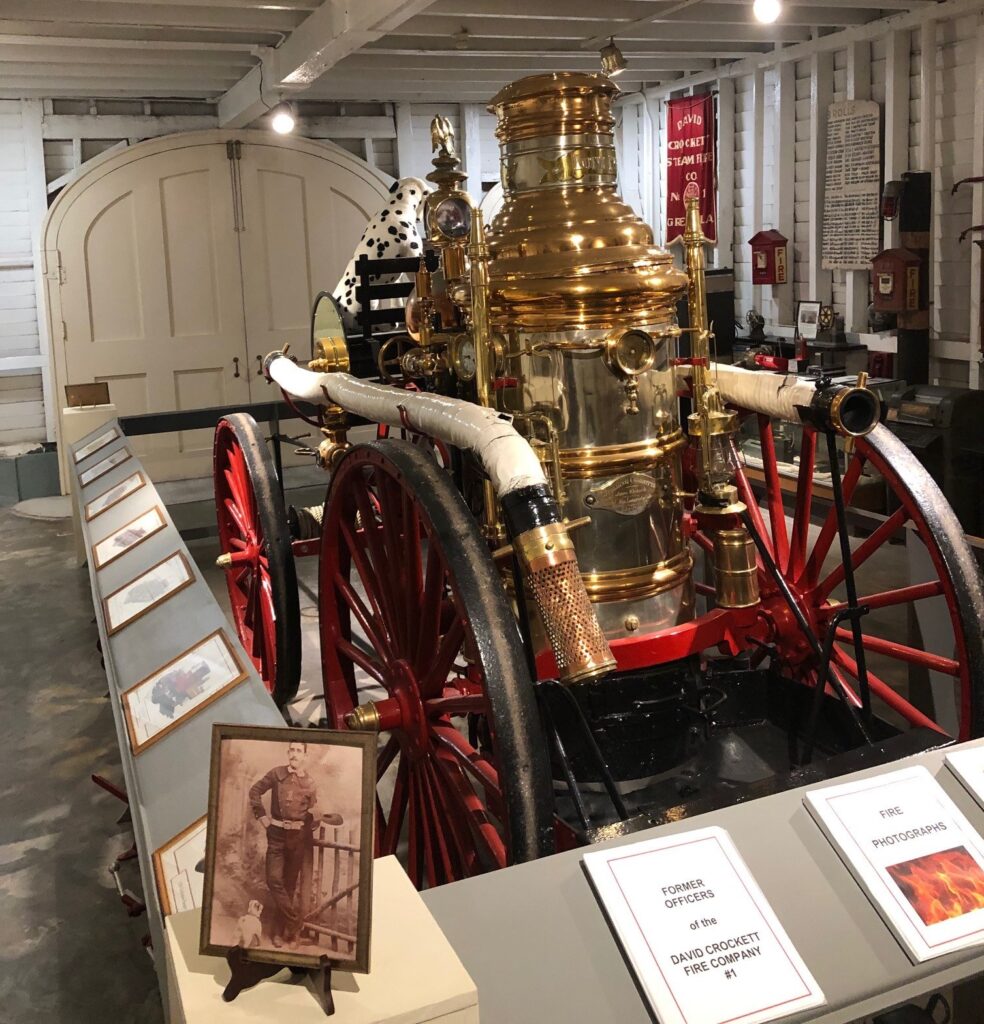
The steam pumper was christened the “Iona Iver” in 1884 named for the daughter of a fire company organizer, Captain Michael Iver. This small bench was later mounted on the engine front to seat the child during ceremonial events.
When the fire company purchased the steam fire engine, funds weren’t available to buy a horse to pull it, a quicker way to get to the fire than with the firemen towing it manually through rained rutted streets in the dark. The station became dependent on borrowing a horse from merchants.
A baker named Terrance Gegenheimer whose bakery was across the street from the fire station had horses that he used for his bread deliveries. The baker would kindly loan out his horse Bill to pull the pumper to the fire. Bill was kept in a pasture next to the bakery so he could see the firehouse and clearly hear the alarm ringing in the belfry.
It is said that when the fire alarm sounded, Bill would rear up on his hind legs and neigh, ready for action. In fact, the story goes that one day the baker was left standing, holding two loaves of bread at a Lavoisier Street residence when Bill took off with the bread-filled wagon as the fire alarm sounded!
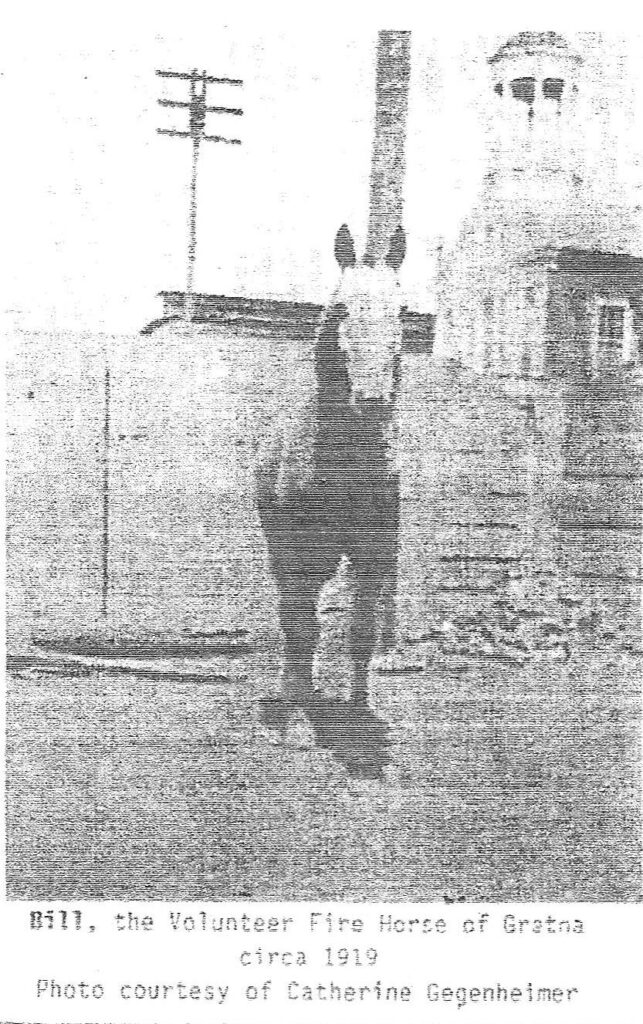
So said, Mr. Gegenheimer realized he couldn’t continue to have his horse runoff from a delivery every time bells rang, especially since the bells at St. Joseph Church rang throughout the day. He generously donated a different horse to the fire company. There is no record of what happened to Bill, easily one of the company’s best volunteers ever!
As written in “Gretna-A Sesquicentennial Salute, VI. The Bucket Brigade” by Mary Grace Curry, “Some say Gretna’s greatest era of development began with the organization of a volunteer fire company.” Some information used in this article was written from the contents of her book.
After a house fire in 1841, a group of prominent Mechanikham, now Gretna, citizens gathered and decided to organize a group to protect against future fires. A bucket brigade, the Gretna Fire Engine Company No. 1 was formed in 1844, renamed 30 years later.
The fire company later purchased a hand-pumped engine similar to a railroad sidecar that used four men on each side to operate it. The water came from wells dug at street corners and backyard cisterns.
The land at the present site of the fire museum was purchased for $350 in 1859, construction began soon after. The invention of steam engines mid- 19th century and the purchase of Gretna’s own “pride and joy” brought attention to the material culture of firefighting. The old pumper, a source of pride to the firemen was often decorated with flowers for important occasions.
Curious crowds would show up to watch fires, eventually creating the need for extra police details to preserve law and order. The firehouse became a part of the community beyond satisfying the community’s fire protection needs. The upstairs of the firehouse, a large hall became a popular site where social gatherings were held.
By 1890, the Union Oil Company erected a 110 ft. water tower at 1st and Amelia Streets and allowed the city to tap the reservoir. A 6” pipeline ran to 8th Street with hydrants placed at each street. After Gretna was incorporated, waterlines were installed throughout the city, an improved water source for firefighting.
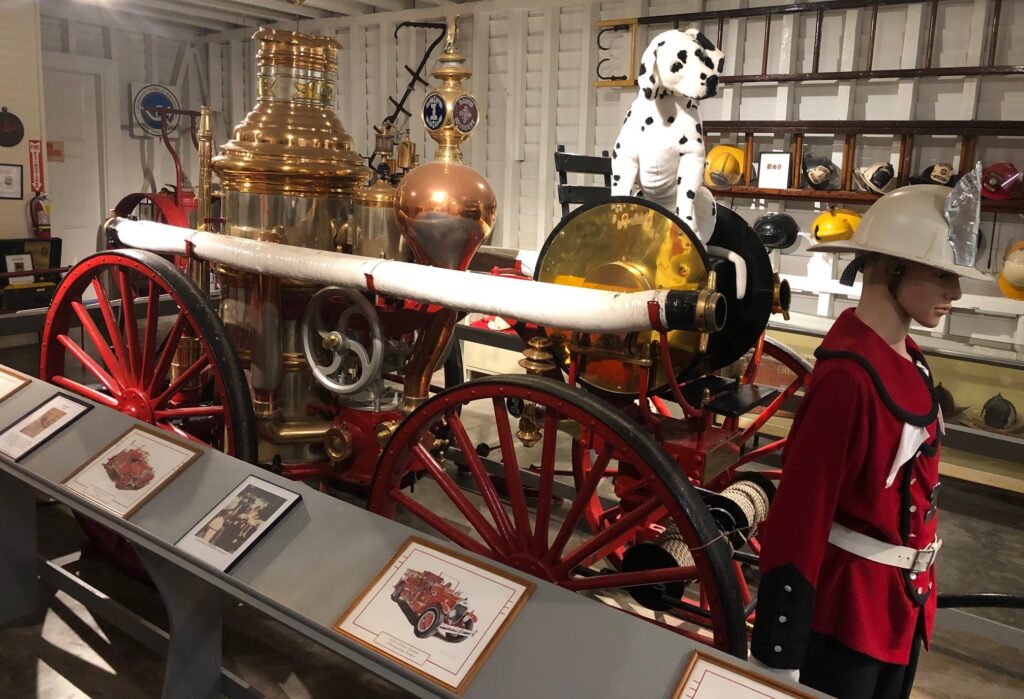
In 1918, the fire company purchased a second-hand White Motor passenger car for $1,800 that was converted into a hose wagon with a trailer hitch to pull the old pumper to and from fires. The “pride and joy” was used another decade until updated fire equipment was purchased.
In the 1930’s, several things happened to enhance firefighting efforts. There was the acquisition of a modernized triple combination pumper with 1600 ft. of hoses that could pump 600 gallons of water a minute, and held chemical tanks and hand extinguishers.
A big step was the installation at the fire station of a modern fire alarm system that connected 35 fire alarm boxes throughout the city. Residents were given a code for each alarm box that would sound. Volunteer firemen and locals could determine where the fire was located by counting the beats of the alarm.
Another improvement, a 10” water main connected to the Mississippi River was constructed to encircle the downtown business district. Large fires could then be controlled through water pumped from New Orleans Dock Board fire-tugs.
Proud of their Company, the Crockett firemen never lacked a chance to pull out the old steam pumper and produce the very finest of parades. For many decades, extensive Fireman’s Day Parades were held to the delight of the community. A Fireman’s Picnic followed with games, music and various entertainment.
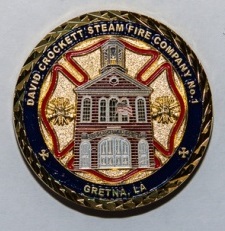
In 2013, Steve Barnes, a fan of fire equipment and a visitor at the fire museum realized that the clock on the engine was an original and broken. Barnes, who had never seen a clock on a steamer before was a member of a group of local clock tinkerers, Creole Chapter 43 of the National Association of Watch and Clock Collectors.
His group agreed that it had to be restored correctly, wanting everything on this rare, early piece to visually look like it did in the late 1800’s.
The clock was restored compliments of Creole Chapter 43 with the majority of work performed by member Joel Dunipace from Ocean Springs, Mississippi. Many intricate and special processes were necessary for a proper mechanical and dial restoration. With a new bezel and latch it works like new. The clock is a “Seth Thomas’ Sons & Company” marine lever escapement movement that was manufactured between 1865 and 1879.
The restoration which was finished just in time for the old pumper to be on display at Heritage Day, the kick-off event of Gretna’s Centennial celebration. Harlan Hock assisted in the clock repair and for anyone interested in old clock and watches, can be reached at 504.390.0020.
David Crockett Company No. 1 firemen who provide a feeling of fire protection safeness are especially loved by locals and very visible in the community, participating and assisting at special events as well.
###



